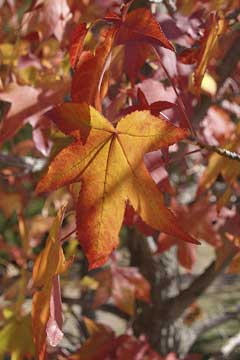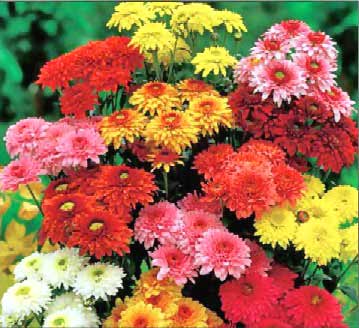With Gill Storey
 November often starts here with a heavy frost.
November often starts here with a heavy frost.
Make sure to prepare for it and to strengthen your fences. There are hungry boars, deer and hares in the hills, all anxious to share in the crops in the garden. The abundance of the hedgerows has now almost passed except for the fruit like medlars (néfliers) which should be gathered after a frost.
However, hawthorn berries and rosehips abound in the hedges, giving a brave touch of colour. The kakis should soon be ready to harvest and the reddish autumn foliage and the golden globes of the persimmons colour the garden.
Birds adore persimmons and now,  when they are ripe, they are attacked by starlings having a good feast before joining their flocks for the autumn aerial ballets and migrating to Africa.
when they are ripe, they are attacked by starlings having a good feast before joining their flocks for the autumn aerial ballets and migrating to Africa.
There are still some harvests to gather in the garden – the last few marrows and gourds need to be picked before the frosts, and the rows of parsnips are now demanding to be harvested to provide winter delights such as parsnip chips and curried parsnip soup, which are practically unknown to the French.
The cardoons are beginning to sprout again and provide an attractive source of winter colour with their grey-green foliage.
One can continue planting overwinter crops such as beans and winter lettuces.
It is a good time to collect leaves, twigs and flower heads for drying, such as hydrangea heads, grasses, teasels and seed pods. These can make attractive winter flower arrangements and Christmas decorations, often with a little silver spray or fake frost to give them a seasonal touch. Later on they may be too wind-tossed to be attractive.
Think about autumn colour for future years. Liquidamber  styriaciflua (sweet gum) parrotia persica (Persian Ironwood), acer palmatum (Japanese maples) and beech provide scarlet and golden notes for the garden.
styriaciflua (sweet gum) parrotia persica (Persian Ironwood), acer palmatum (Japanese maples) and beech provide scarlet and golden notes for the garden.
The Autumn Cherry, Prunus x subhirtella ‘Autumnalis Rosea’ has beautiful autumn colour, and as a bonus, flowers in November. Medlars (mespilus germanica) are small enough for the average garden and are rich in colour and self-fertile.
Chrysanthemums, sold everywhere now for Toussaint (All Saints) to decorate cemeteries, are wonderful plants which come in as many shapes, colours and sizes as dahlias, not just those wretched bowls full of forced cuttings.
Roy Lancaster talks about “plants that die nicely” – hostas turning yellow in autumn, bergenias (elephant ears) varied grasses and ferns.
Flower Garden
1. Rake up dead leaves, store them to make leafmould and mulch plants with last year’s leafmould. Good garden hygiene goes a long way in preventing over-wintering diseases and pests.
2. Continue to tidy perennials which have died back
3. Prune shrubs in windy corners to prevent wind rock
4. Trim back berberis and pyracanthas above the berries. Leave the berries for the birds.
5. Organise bird feeding for the winter
6. Put containers on pot feet to prevent waterlogging
7. Take root cuttings of poppies, verbascum, phlox and eryngium
8. Pot up lily and amaryllis bulbs and bring hyacinth bulbs into the light
9. Plant tulips now to reduce risk of fungal diseases
10. Plant bare-root roses and other shrubs
Vegetable Garden
1. Lift Jerusalem artichokes (topinambours) leeks and brassicas as they are ready
2. Harvest kakis after a good frost. Lay them out to finish ripening. There are many recipes on line for persimmons: scones, purees, tarts etc
3. Lift your drying beans. (Coco varieties)
4. Winter prune apples and pears, after leaf fall, taking out crossed over branches. Never over prune – not more than 1/3 of the crown. Take out cankered wood. Trim cherries which are wind blown
5. Put new grease bands on fruit trees to prevent winter moth. There is a product called Glu which is very effective: a treacle-like substance which is applied directly to the bark. Spray with sulphur and Bordeaux mixture combined.
6. In well-drained soils, put straw/fleece over root vegetables
7. Cut and burn asparagus foliage and mulch the bed.
8. Take the time to rotovate or dig over your patch and dispose of weeds by burning or composting
9. Sow green manure (winter rye) to dig in when spring comes.
10. Continue sowing legumes (beans, peas) and garlic.
Water Features
1. Clean any ponds
2. Winterize swimming pools
3. Drain pumps, pipes and hoses.
4. Open outdoor taps and showers and turn off at the main to prevent freezing. Leave open so that any water can expand out.
5. Insulate any outdoor mains taps with polystyrene bobbles.
END NOTE
Gardening now is much less about the pleasures of sitting on a lawn, enjoying the sight of colourful flowers and the scent of lavender and rosemary.
Now, the gardener thinks about consolidating the garden’s growth in the previous season and preparing for the delights of the coming year. The early evenings are a time for enjoying seed and plant catalogues for next year’s planting. Look on the web for ideas if there are no books available.
Why not research Gardening by the Phases of the Moon? There are several good web sites which are full of great ideas for the practical gardener and help keep one on track.
Lay out your planting plan for the kitchen garden (see Gardening Notes for January). It is a time when a lot of hard work (in acceptable temperatures) leads on to the rewards to be earned. A smoking bonfire is one of the delights of the autumn season and brings potash for the spring.
REMEMBER TO FEED THE BIRDS

